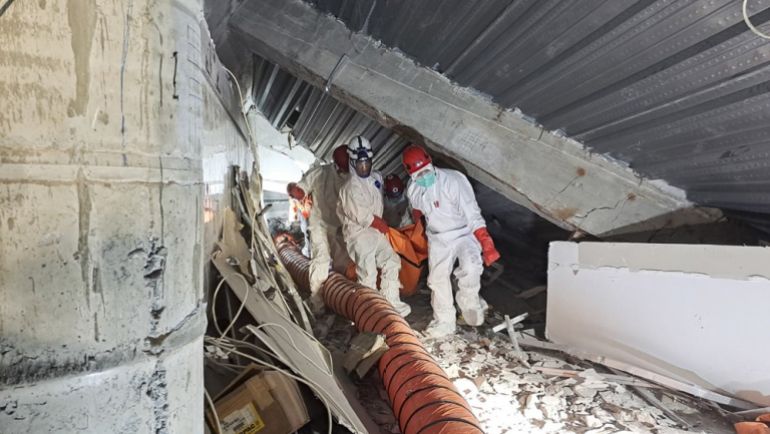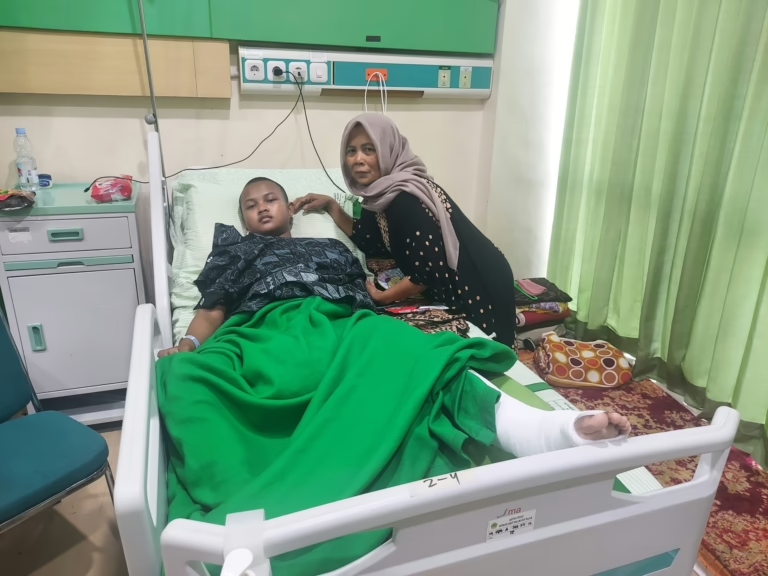Sidoarjo, Indonesia – On Monday, sixteen-year-old Muhammad Royhan Firdaus had just completed his prayers on the first floor of the Al-Khoziny Islamic Boarding School in Sidoarjo, East Java, when suddenly something struck his head.
Looking up, he witnessed fragments of the ceiling collapsing onto him and the other boys, aged between 12 and 18.
“At first, I thought it was an earthquake,” Muhammad recalled. “Everyone immediately started running.”
However, it was not an earthquake.
For several weeks prior, construction crews had been working on the school, pouring concrete on the upper two floors. The excessive weight caused the building to give way in a layered collapse, which Indonesian authorities likened to a “pancake” effect.
As Muhammad fled, he stumbled multiple times and was struck by falling debris, including large chunks of cement. Driven by adrenaline, he initially felt no pain, but once outside and collapsed on the ground, he realized his leg was broken. Additionally, he suffered a severe shoulder fracture that required surgical insertion of a metal pin at Siti Fajar Hospital in Sidoarjo.
While over 100 students escaped the collapse, the death toll had climbed to 40 by Sunday.
Rescue operations continue to search for survivors, with approximately 27 students still believed trapped beneath the rubble. On Thursday, thermal imaging drones reported no signs of life.
A Devastating Incident
In the wake of this tragedy, concerns have emerged regarding the building’s safety and the decision to continue construction while students were present.
Despite this, neither Muhammad nor his mother, Yuni, expressed fear about his return to the school, where he had been enrolled since age 12.
“I’m not afraid to go back,” Muhammad said, while his mother hoped he could resume his education once the school is rebuilt.
“We see this as a heartbreaking accident,” Yuni stated, emphasizing that she does not wish to assign blame to the school’s administration.
Nearly all the parents interviewed by Al Jazeera expressed a desire for their children to return to the institution.
Syamsul Arifin, a sociology of religion professor at Muhammadiyah University in nearby Malang, noted that Islamic boarding schools like Al-Khoziny hold significant importance in conservative religious communities. This context helps explain the reluctance to fault the school’s leadership.
“Although parents are naturally distressed, they tend to avoid blaming the school’s owners or leaders due to the patron-client dynamic,” he explained.
These institutions provide a “protective spiritual environment” for students, which is why parents place their trust fully in the school authorities, Arifin added.
Spiritual Leadership and Community Trust
Indonesia is home to over 30,000 pesantren, or Islamic boarding schools, where students reside in dormitories and learn under the guidance of religious scholars known as kyai or ustadz.
While pesantren primarily focus on religious teachings, many, including Al-Khoziny, also offer secular education.
East Java alone hosts nearly 7,000 such institutions.
“Kyai and ustadz command immense respect, especially in conservative regions like East Java, as they are regarded as individuals of profound knowledge and wisdom,” Arifin explained.
They also serve as pivotal figures in their communities, often sought for spiritual advice.
“Their devoutness leads people to view them as closer to God, which explains the deep reverence they receive,” he added.
“When incidents like this raise safety concerns, parents often turn to religious beliefs and traditional views of spiritual authority for comfort.”
Founded in 1927, Al-Khoziny has historical significance, with several founding members of Nahdlatul Ulama-the world’s largest Muslim organization-having taught or studied there. This legacy solidified its reputation as a hub of religious scholarship and spirituality.

Clinging to Hope Amidst Loss
Muhammad Ali, who attended Al-Khoziny as a youth just like his son, chose to enroll his 14-year-old son, Muhammad Fajri Ali, at the same school.
His son was inside the building when it collapsed and remains missing. Since learning of the disaster through social media on Monday, Ali has stayed at the site, hoping for a miracle.
“I’m praying for a miracle,” he said.
Ali shared that senior school officials met with parents and offered their apologies.
“Before meeting with the school leaders, we parents of the missing students gathered and agreed not to hold the school or anyone else responsible,” he explained.
“I shook hands with the school leaders, and they embraced me,” Ali added. “We believe this was God’s will.”
Mohammad Abduh, a civil engineering lecturer at Muhammadiyah University, reviewed images of the damaged building and suspects the ongoing construction on the upper floors triggered the collapse.
“The pouring of concrete can weaken a structure, especially due to vibrations and the drying process,” he said. “It’s also possible the supporting pillars were insufficient to bear the added load.”
“In Indonesia, it’s common to see ‘living structures’ where additional floors or rooms are added over time without proper planning, which can compromise safety,” Abduh explained.
He noted that the school was reportedly constructing a prayer hall and ablution facilities on the upper levels.
“Regardless of the purpose, no other activities should occur inside a building during construction,” Abduh emphasized.






















